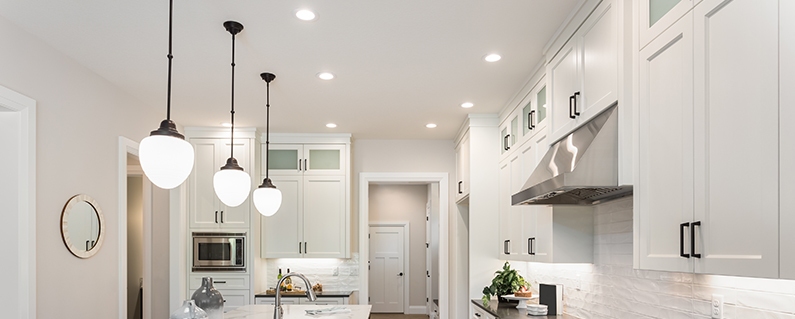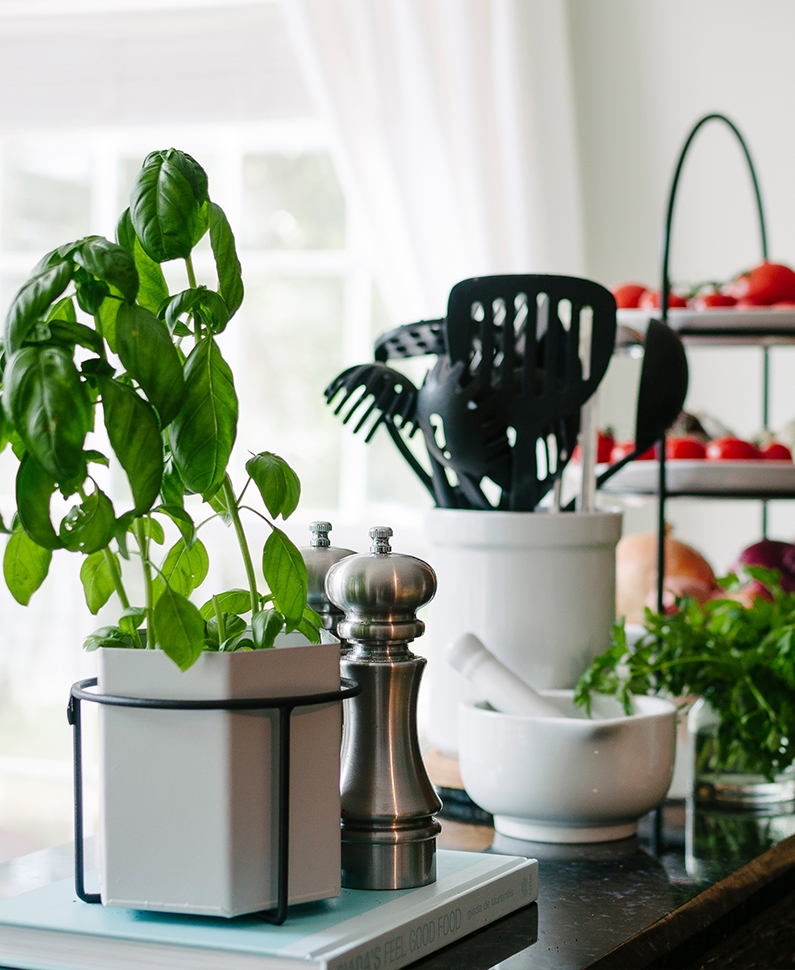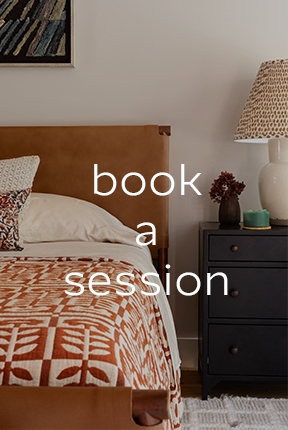Lighting Guide for Your New Kitchen
When you are building a new home or renovating an existing home, there are so many decisions to make. One of the most important decisions is lighting. It affects how you feel and work inside your home. Let me just say that again…it affects how you feel AND work inside your home. Isn’t that just about everything? You want to feel good and be productive while you’re at home. So it makes sense why you would want to have a good handle on this oh-so-important area of lighting, since it affects EVERYTHING. And what better place to start, than the heart of the home…the kitchen?

In this article, we will be answering 3 very common questions about kitchen lighting:
- What type of kitchen lighting is best?
- What is the best color temperature for a kitchen?
- How bright should my kitchen lights be?
So what type of lighting is best for the kitchen?
So really quickly…let’s start with four types of lighting: Natural, Ambient, Task, and Accent/Decorative lighting. I’m not going to get too crazy with this, but I just want you to know the four areas you need to think about and what they are. Also, for now let’s put aside the style of fixtures…you can think about that after you get a good handle on the basics.
- Natural
- Ambient
- Task
- Accent/Decorative
Natural Kitchen Lighting
This is the best kitchen lighting…light from the sun outside. When you’re building a new home, thinking about windows in the kitchen is your first lighting decision you are going to make. In general, the more the better, but keep in mind the cost, and appearance from the outside as well. Also, your location can affect the type of lighting you’ll get from the outdoors, especially as seasons change. Our clients in Florida (Jacksonville & Orlando) have very different levels of outdoor light compared to our Ohio customers (Cleveland & Columbus). Consider how much much light you’ll get from the sun at different times of the year.

Obviously you don’t have control here over what color temperature the light is from windows, but as you’re thinking about your lighting plan, consider how the light from the windows will appear in the room at different times of day and how it will affect the temperature of the room. This may or may not affect your decision on where to place the windows and how big they will be, but this will help you decide what type of window treatments you will have, what other types of lighting you will have in the room and where you will place it.
Placement: Your architect, interior designer and builder can help you with this. It is nice to place a large window above the sink, especially if it has a good view. It is also great to use windows to highlight a feature in the kitchen, such as a range hood or some beautiful cabinets.
Ambient Lighting
This is the most general type of lighting. It’s the lighting that will fill the room, especially when it’s dark outside and you’re not getting all that nice natural light into the kitchen through windows. This lighting is not meant to illuminate one specific area…it’s meant to be diffused across the kitchen and provide general illumination.

Placement: It is usually placed overhead, in the form of recessed down-lights, cove up-lighting, pendants, hanging fixtures or track lighting or it can be in the form of sconces that wash the walls with light. Some lighting can provide ambient light while at the same time, serving as an accent light or another type of light, so let’s not get too hung up on the categorization. Just know that every kitchen needs uniform light to illuminate the room, so ambient kitchen light is the starting point and building block.
- Tip: I like to use a combination of recessed lighting and pendant lighting to create ambient light. Also, you will want everything on dimmers and to be on separate switches to be able to adapt your lighting to the environment you’re trying to create.
Task Lighting in the Kitchen
Now we get a little more focused. This is the lighting that is concentrated in one area, to further brighten up, say, the under the cabinet area of your kitchen counter top where you’ll be chopping veggies and you don’t want to chop your finger off. That’s task lighting. This lighting can be achieved through under-cabinet lights, recessed can lights in the ceiling, and pendant lights.

Placement: When you’re using recessed can lights for task lighting, they should be placed directly over the edge of the counter, about 24″ out from the wall, so that when standing at the counter, you don’t block the light. Undercabinet lighting should be placed in the front of the cabinet, behind the lip. It’s much better to place undercabinet lighting at the front, angled towards the wall, than the other way around. If you want your pendant lights to do double-duty, functioning as accent and task lighting, place them over work areas and surfaces like sinks and the island. Be careful with this, though, as hanging too many ceiling fixtures will result in visual clutter.
- Tip: Remember how we used recessed lighting as ambient light too? It can work double-duty if you get the bulb type and placement correct. It’s like a shirt that can go from day to night, depending on what pieces you layer it with.
Kitchen Accent Lights & Decorative Lighting
This is the pretty part, but don’t underestimate its power and importance. This isn’t the unnecessary “cherry on top” lighting. It directs one’s eye through your kitchen, provides visual interest, making your kitchen feel special, and draws people to where you want them to look or gather. So yeah…not just a pretty face. Accent lighting can come in the form of cabinet lighting, pendant lighting (see the overlap again?) or uplighting on walls.

Placement: When it comes to cabinet lighting, it is good to use lights pointed down or facing the wall to highlight special china or decorative accents that are behind glass cabinet doors. Pendant lights should hang approximately 40 inches above the island or tabletop, and the number depends on the size of the island and type of fixture. If your cabinets do not go all the way to the ceiling and you want to use uplighting, it’s best to allow a minimum space of 12 inches between the light and the ceiling to avoid a halo effect above the cabinets.
- Tip: I just love beautiful things that serve a purpose as well, so if I am lighting the interior of a cabinet with a glass door, I want it to not only highlight what’s in it, but I want it to provide soft, ambient light as well. I like the look of mounting LED strip lights on the back of a floating shelf, which washes the wall with light rather than directing a harsh spotlight down on objects and creating shadows. You will need a few inches between the back of the shelf and the wall to achieve this look.
What is the best color temperature for kitchen lighting?
Color temperature is measured in Kelvins. In kitchens, it is best to go with a color temperature that is neutral to a little cooler (bulbs with Kelvin numbers between 3000k to 4000k), especially if it is a lighter-colored kitchen with, say, white cabinets and light countertops. The lighter colors look better when cool light bounces off of it, and the cool light is more energizing, which people typically like in the kitchen. Keep this general color range consistent across all types of light in the kitchen, unless you’re trying to achieve a warmer, cozy feel in some instances. Regardless of the bulb type (LED, incandescent, CFLs, halogen, etc), you should be able to find one within that temperature range for each of your light fixtures.
Something that is also related to color and very important in the kitchen is CRI (color rendering index). It’s basically how accurate the colors appear under that light…100 being the bulb CRI that most realistically reveals the color of the object it is shining on. You can imagine how important this is in the kitchen, when you’re looking at that gourmet meal you just made and you want it to look as it should…appetizing. A CRI of at least 80 is often fine…90+ being ideal.
How bright should the kitchen lighting be?
When you’re looking for ambient light especially, you’ll want to get light fixtures that can accommodate bulbs that are bright enough for the space. Brightness of the bulb is measured in lumens. Without getting too much into voltage and watts and how it relates to lumens, just read the specs on your light fixture you’re considering and make sure you can use at least an 800 lumen (typical 60-watt) bulb.
The overall kitchen brightness depends on the type of lighting combination you use, the color of the walls, size of the room, etc. According to Houselogic, the lumens from all of the lights in the kitchen should add up to 5,000 to 10,000 and keep in mind a typical 60-watt home bulb produces about 800 lumens. I recommend your base ambient lighting should have bulbs that give off about 800 lumens, your task lighting might need to be brighter, and your accent lighting may need to be dimmer. Also, speaking of dimmers….I highly recommend placing all lights (except maybe in-cabinet accent lighting) on dimmers for more flexibility and energy savings.
In a nutshell…
In short, there are four types of lighting you should think about for a kitchen: Natural, Ambient, Task and Accent lighting. The purpose of one light can overlap with the purpose of another light (ie. pendant lights can be used to add ambient light and also to add decorative interest) so be sure to think about what purposes your lighting is serving before deciding placement. When it comes to color, think about what you want to achieve in each area of the kitchen, keeping in mind that kitchens usually call for more neutral and cooler whites. When it comes to brightness, in general you want the ability to light the kitchen well, while also being able to dim certain areas at certain times. If it all seems overwhelming to think about, reach out to an interior designer who can help you plan the perfect kitchen lighting for your unique space and needs.
